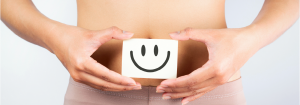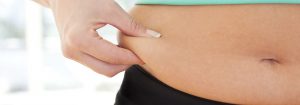Do you feel the need to breathe through your mouth to take in enough air? If that’s the case, you’re not alone. Estimates on the prevalence of mouthbreathing tend to range from 5 to 75% of a population. In Brazil, two independent studies showed that more than 50% of children are mouthbreathers, but it may be more common than that.
However, breathing through your nose is the natural way to breathe. Mastering nasal breathing is a simple technique that can really make a big difference to how you feel.
In this article, we explore how to breathe well, methods, and the consequences of not breathing well.
Who might benefit from better breathing?

Since the typical respiratory rate in adults at rest is considerably faster than what’s considered good for a healthy stress response (12-20 breaths per min compared to the more optimum 5.5–10 breaths per minute), most of us could potentially benefit from slower breathing through the nose.
Nasal breathing could have particular benefits for people with asthma, allergies, stress, anxiety, poor exercise tolerance, poor dental health and infections, nasal congestion, those with sleep apnoea, and snorers.
Breathing therapy might also be helpful for people with cardiovascular disease.
Slow breathing at around 6 breaths per minute is linked with improved response to stress caused by low oxygen levels and the preservation of healthy blood pressure responses in well individuals, people at high altitude, and people with heart failure and hypertension.
Slower breathing activates the parasympathetic nervous system – the calming arm of our nervous system. Measuring your Heart Rate Variability (HRV), which is the beat-to-beat fluctuations in time between heartbeats, may help you to observe the calming influence of mindful rhythmic breathing. There are tools (with earpieces or chest straps) that can measure HRV in real time as we breathe. You can find out more here.
Very rarely, breathing at a rate of fewer than 12 breaths per minute can be a sign of conditions, such as poisoning / overdose / head injury. If you’re feeling otherwise unwell with a slower breathing rate, please consult a medical professional.
Why you should practise nasal breathing
Nasal breathing has some major advantages over mouth breathing including:
- Filters out dust, bacteria, virus and other airborne particles from inhaled air. Sensors in your nose can also release antimicrobial chemicals, such as cathelicidins, when detecting microbes in the air.
- It’s important for your sense of smell and your ability to “sniff out” and remember both good and bad odours in the environment, which has implications for memory more generally.
- May improve cognitive function. Studies have found that controlled nasal breathing can lead to an improvement in some cognitive processes, leading to faster response times.
- Keeps your nasal lining moist. In your nasal and respiratory passages, the mucous lining and small hairs called cilia constantly clear your airways of inhaled particles. For this process to work, it needs to be moist.
- Warms, humidifies and pressurises the air as you breathe which improves your ability to exchange oxygen and carbon dioxide in your lungs.
- Studies indicate that it can boost nitric oxide concentrations. Your nose and sinuses produce the antibacterial, antiviral, anticoagulant (prevents blood from clotting) gas called nitric oxide (NO).
- Nitric oxide enhances your oxygen uptake by dilating your blood vessels, which can help lower your blood pressure. Lower blood pressure is important for your cardiovascular health.
- Combined with slow breathing and prolonged exhalation, it can improve carbon dioxide levels leading to better oxygen deliverability and improved blood circulation.
- There’s roughly a 50% greater resistance to the flow of air when you breathe through your nose which stimulates your diaphragm into action.
One of the easiest ways to regulate your autonomic nervous system is to take control of your breathing as often as possible. That means breathing through the nose and controlling the diaphragm.
Why you should avoid breathing through your mouth
There are major disadvantages to breathing through your mouth:
- Bypasses the protective functions of your nose, such as warming, humidifying, and filtering inhaled air.
- Produces less nitric oxide.
- Is shallow and inefficient.
- Dries out your mouth – removing your first defence against oral bacteria which can lead to dental infections, bad breath, dental and tooth decay.
- Causes your body to lose 42% more water by exhaling from your mouth compared to breathing out through your nose.
- Is linked to reduced exercise capacity, snoring and sleep apnoea, facial abnormalities, allergies and asthma.
- Some researchers suggest that breathing through the mouth at a faster rate during childhood may contribute to developing constricted facial features such as crowded and crooked teeth.
Whilst research in adults is limited, in a study amongst mouth breathing children, 86% slept with their mouth open, 79% snored, 77% had itchy noses, 62% drooled on the pillow, 62% had night-time breathing difficulties or restless sleep, 49% had blocked nose and 43% showed daytime irritability.
Causes of mouth breathing
Mouth breathing can be caused by a chronically blocked up nose, for example due to allergies, or infection nasal septal defects, or enlarged tonsils and adenoids. Other causes include stress, inflammation, air pollution, dry indoor air, or lower duration of breastfeeding as an infant.
Consequences of over-breathing – also known as hyperventilation

When we breathe through our mouth, we tend to over-breathe. Over-breathing can be defined as hyperventilation (i.e., breathing too fast and too deep). It’s a normal response to sudden danger or stress which can become habitual. If you regularly breathe through your mouth, especially when resting, it’s likely you’re over-breathing.
What happens when we over-breathe?
- Over-breathing can lead to too high a concentration of oxygen (O2) relative to carbon dioxide (CO2) which causes small airways and blood vessels to constrict, whereas higher concentrations of carbon dioxide open your airways and dilate your blood vessels.
- The net effect of a buildup of oxygen relative to carbon dioxide is a reduction in oxygen delivered to the tissues and organs which can contribute to cellular damage and inflammation.
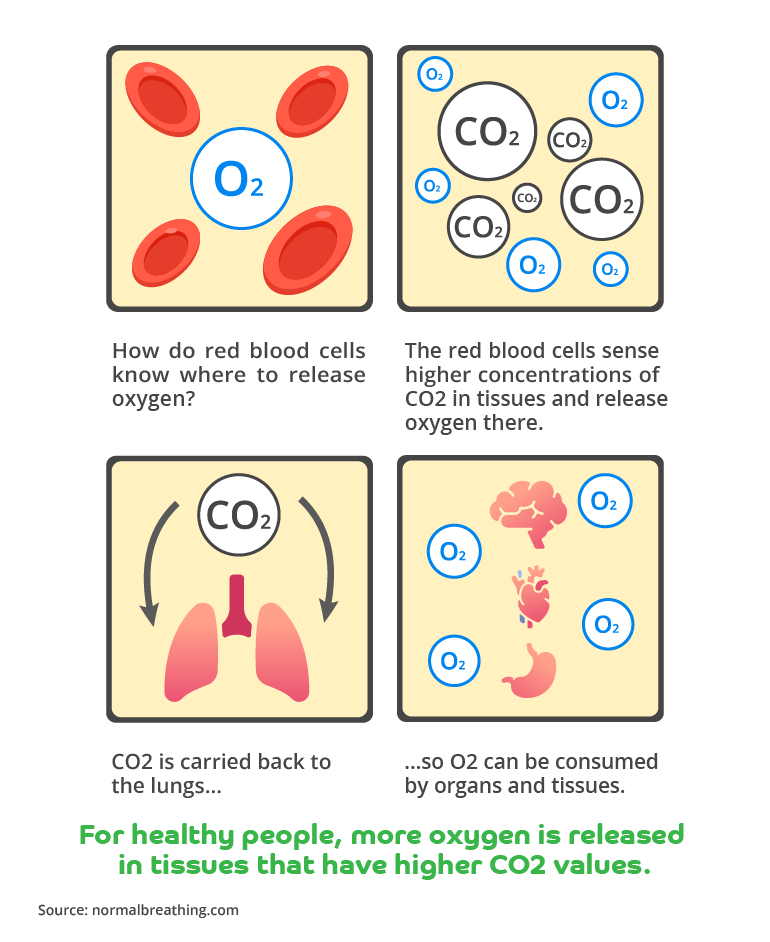
How to breathe well: low and slow and through the nose
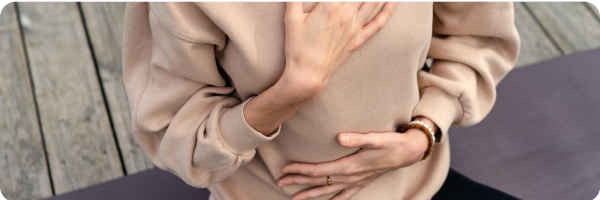
The power of breathing has been known for thousands of years around the world and there are hundreds of different techniques, traditions and methods of breathing, for example pranayama and yoga. Some new interpretations of ancient breathing techniques include: Buteyko, Wim Hof, and Soma.
Constantine Buteyko was a Ukrainian doctor who, in the 1950s, watched how sick people breathe and noticed the sicker they were the worse their breathing became. The Buteyko breathing techniques (BTT) he developed, mostly involves breathing through the nose, breathing less and breath holding. Progress is monitored by tracking breath hold times in a controlled way. Buteyko himself, attributed the resolution of his own hypertension to the BTT he developed. Also, the Buteyko Breathing Technique might be an effective way to manage asthma symptoms.
Soma Breath, on the other hand, is a system of breathing developed by Niraj Naik who, similarly to Wim Hof, teaches breathing techniques based on traditional yoga breathing practices.
This article discusses the potential benefits of “low and slow” breathing through the nose.
To begin, notice how you’re currently breathing:
- Bring your attention to your breath and notice the flow of air as you breath in and out.
- Try it in front of a mirror. Place one hand on your stomach between your navel and lower ribs and the other hand on your chest. Take a deep breath in and notice which hand rises first?
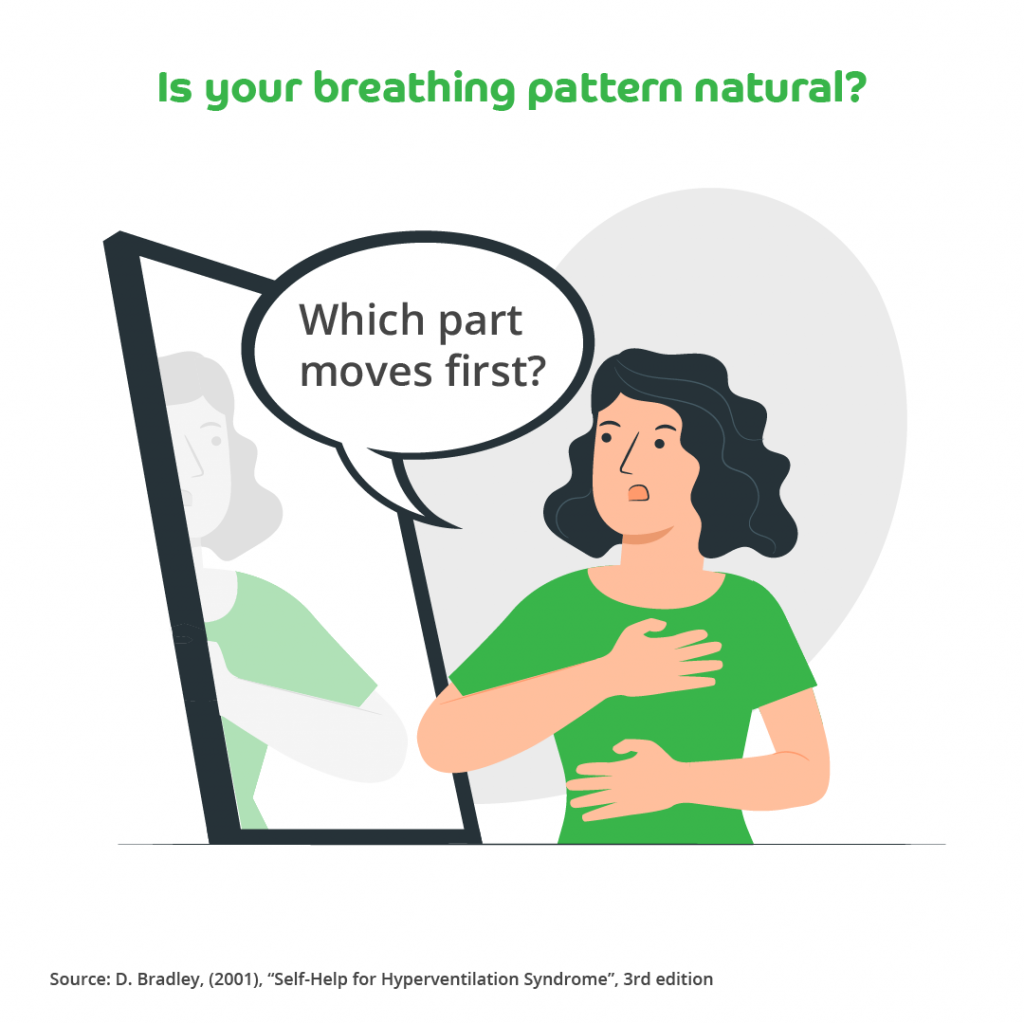
When breathing in through the nose (which is the physiologically natural way), the belly should rise first, with minimal upper chest movement. Abnormal breathing is observed as an increased movement of the upper compared with the lower chest.
So now that you’ve noticed your current breathing, let’s explore the steps for nasal breathing.
How to breathe through your nose and engage your diaphragm:
Engaging your diaphragm, also called diaphragmatic or abdominal breathing, increases the volume of air you inhale, whilst reducing the number of breaths per minute. Breathing “low and slow” and exhaling slowly buys time and allows CO2 to build up before the next inhalation.
Here’s how to get started with nasal breathing:
- Stand or sit up straight with shoulders relaxed.
- Close your mouth (lips and teeth together) with your tongue touching the roof of your mouth.
- Place one hand on your stomach between your navel and lower ribs and breath in gently through your nose into the area behind your hand. Your belly should rise naturally.
- As you breathe out through your nose, you let go effortlessly, allowing your belly to fall, as your diaphragm (the muscle which separates your chest cavity from your abdomen) returns to its domed resting position around the abdomen.
- Your breath should be gentle, smooth and silent and not forced or effortful.
- Focus on a slow “out and in” rather than up and down, breathing from your belly. Feel your belly expand as you breathe in and relax as you breathe out. Your back and sides should also expand, and your chest should remain relaxed.
- If you find yourself breathing in a jerky way, mildly resisted breathing can help control your diaphragm. Place a book on the area around your navel whilst lying down. Once you’re comfortable with that, try a slightly heavier one. If you have problems with gastro-oesophageal reflux, practice in a semi-reclining position.
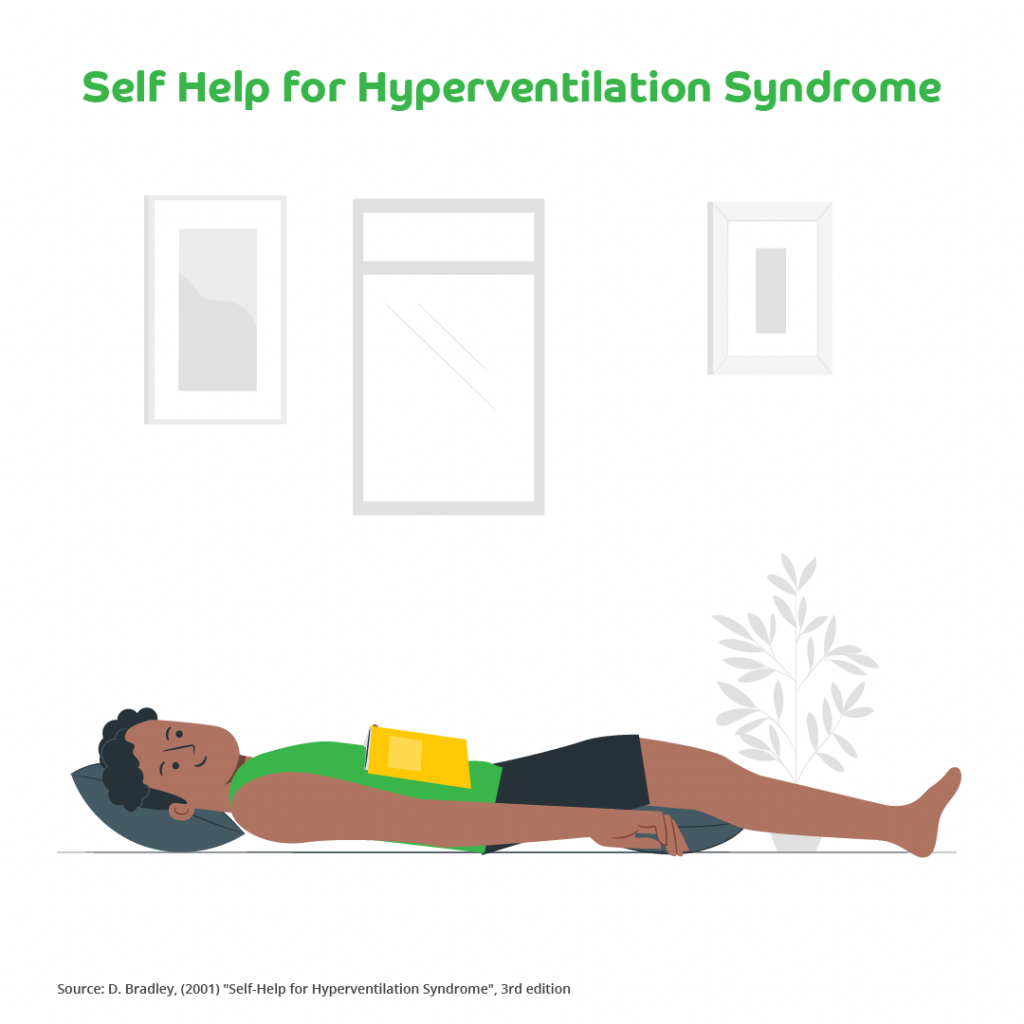
- Practice makes perfect – if you’ve been breathing through your mouth for a long time, it might take a bit of getting used to.
Time honoured breathing techniques from yogic, Buddhist chants and the Catholic rosary all seem to support a pattern of about 6 breaths a minute (or approximately 5.5 seconds inhale and 5.5 seconds exhale). This is further supported by modern studies which have found this breathing pattern may lead to reduction in anxiety, improved blood pressure and greater ventilation of the lungs.
How to stop mouth breathing at night

Whilst not for everyone, one approach that has been suggested is to consider gently taping your mouth at night.
If you want to give mouth taping a go, try placing a small 1-2 cm wide strip of tape placed across both lips in the centre of the mouth. This should act as a prompt to keep your mouth closed, but for safety reasons should not completely cover your mouth. You should be able to remove the tape easily with your tongue.
Even those with sleep apnoea or people who use a CPAP machine are thought to be safe to try mouth taping.
Good air quality is crucial for healthy lungs, so investing in an air purifier can also be beneficial.
Babies and very young children shouldn’t mouth-tape. However, it can be generally safe for older children providing their mouth isn’t fully covered and they can open their mouths to talk and breathe if they need to. Only a small strip of tape in the middle is required to serve as a reminder to keep the mouth closed.
If you have severe claustrophobia or allergies, a deviated septum or if you’re pregnant, sick or congested we strongly recommend you speak to your GP before considering mouth taping.
If you have any sort of nasal blockage, it can be valuable to think about possible causes. For example, a dusty bedroom or mould issues in the home can all contribute to nasal congestion. If you’re struggling to resolve the source of your congestion, please consult a GP or suitable healthcare practitioner.
Take control of your breathing
Now you have had some insight into the benefits of nasal breathing, why not give one of the breathing techniques mentioned above a try, if you haven’t already, and see if you notice a difference to how you feel?
Close your eyes, breathe in through your nose, into your belly. 5 seconds in and 5 seconds out. And repeat.
In the spirit of improving or maintaining your wellness, the Evergreen Life app is bursting with helpful overall wellbeing tips and helps you stay in control of your health and related information. Why not download the app today?
Reviewed by:
Anna Keeble MA BA Wellbeing Expert
Dr Claire Marie Thomas MRCGP DFSRH DTMH DipNLP MBChB BMedSci Medical Expert
Asthma and mouth breathing
Abreu RR, Rocha RL, Lamounier JA, et al. (2008). Etiology, Clinical Manifestations and Concurrent Findings in Mouth-Breathing Children. Jornal de Pediatria 84: 529–35 (doi: 10.2223/jped.1844).
Burgess J, Ekanayake B, Lowe A, et al. (2011) Systematic review of the effectiveness of breathing retraining in asthma management. Expert Rev Respir Med. 5: 789-807 (doi:10.1586/ers.11.69).
Hallani M, Wheatley JR, and Amis TC (2008) Enforced Mouth Breathing Decreases Lung Function in Mild Asthmatics. Respirology 13: 553–58 (doi: 10.1111/j.1440-1843.2008.01300.x).
Izuhara Y, Matsumoto H, Nagasaki T, et al. (2016) Mouth breathing, another risk factor for asthma: the Nagahama study. Allergy 71: 1031–1036 (doi: 10.1111/all.12885).
Mummolo S, Nota A, Caruso S, et al. (2018) Salivary Markers and Microbial Flora in Mouth Breathing Late Adolescents. BioMed Research International 2018: 8687608, 8 pages (doi: 10.1155/2018/8687608).
Trabalon M and Schaal B (2012) It Takes a Mouth to Eat and a Nose to Breathe: Abnormal Oral Respiration Affects Neonates’ Oral Competence and Systemic Adaptation. International Journal of Pediatrics 2012: 207605 (doi: 10.1155/2012/207605).
Thomas M, McKinley RK, Freeman E, et al. (2003) Breathing retraining for dysfunctional breathing in asthma: a randomised controlled trial Thorax 58: 110-115. (doi: 10.1136/thorax.58.2.110).
Breathing
Bilo G, Revera M, Bussotti M, et al. (2012) Effects of Slow Deep Breathing at High Altitude on Oxygen Saturation, Pulmonary and Systemic Hemodynamics. PLoS ONE 7: e49074. (doi: 10.1371/journal.pone.0049074).
Bernardi L, Sleight P, Bandinelli G, et al. (2001) Effect of rosary prayer and yoga mantras on autonomic cardiovascular rhythms: comparative study. BMJ 323: 1446 (doi: 10.1136/bmj.323.7327.1446).
Bradley H and Esformes J (2014) Breathing pattern disorders and functional movement. Int J Sports Phys Ther. 9: 28-39.
Lin IM, Tai LY and Fan SY (2014) Breathing at a rate of 5.5 breaths per minute with equal inhalation-to-exhalation ratio increases heart rate variability. Int J Psychophysiol. 91: 206-11 (doi: 10.1016/j.ijpsycho.2013.12.006).
Nestor J (2020) Breath The New Science of a Lost Art Penguin Life.
Nestor J (n.d.) Bibliography & Extended Notes MrJamesNestor.
Buteyko method
Bruton A and Lewith GT (2005). The Buteyko breathing technique for asthma: a review. Complementary therapies in medicine 13: 41-46. (doi: 10.1016/j.ctim.2005.01.003).
McHugh P, Aitcheson F, Duncan B, et al. (2003) Buteyko Breathing Technique for asthma: an effective intervention. N Z Med J. 116: U710.
Cathelicidins
Currie SM, Findlay EG, McFarlane AJ, et al. (2016) Cathelicidins have direct antiviral activity against respiratory syncytial virus in vitro and protective function in vivo in mice and humans. The Journal of Immunology, 196: 2699-2710 (doi:10.4049/jimmunol.1502478).
Facial structure and breathing
Woodside DG, Linder-Aronson S, Lundstrom A, et al. (1991) Mandibular and maxillary growth after changed mode of breathing. Am J Orthod Dentofacial Orthop. 100: 1-18. (doi: 10.1016/0889-5406(91)70044-W).
Mouth Breathing
Abreu RR, Rocha RL, Lamounier JA, et al. (2008). Etiology, Clinical Manifestations and Concurrent Findings in Mouth-Breathing Children. Jornal de Pediatria 84: 529–35 (doi: 10.2223/jped.1844).
Abreu RR, Rocha RL, Lamounier JA, et al. (2008) Prevalence of mouth breathing among children. J Pediatr (Rio J). 84: 467-70 (doi: 10.2223/JPED.1806).
De Menezes VA, Leal RB, Pessoa RS, et al. (2006) Prevalence and factors related to mouth breathing in school children at the Santo Amaro project-Recife. Braz J Otorhinolaryngol. 72: 394-9 (doi: 10.1016/s1808-8694(15)30975-7).
Hsu DW and Suh JD (2018) Anatomy and Physiology of Nasal Obstruction Otolaryngologic Clinics of North America 51: 853–65 (doi: 10.1016/j.otc.2018.05.001).
Lopes TSP, Moura LFAD and Lima MCMP (2014) Association between breastfeeding and breathing pattern in children: a sectional study. Jornal de Pediatria (Versão em Português) 90: 396-402 (doi: 10.1016/j.jped.2013.12.011).
Lumb AB (2017) Functional Anatomy of the Respiratory Tract. Nunn’s Applied Respiratory Physiology. Nunn’s Applied Respiratory Physiology (Eighth Edition): 3–16.e1.
Okuro RT, Morcillo AM, Sakano E, et al. (2011) Exercise capacity, respiratory mechanics and posture in mouth breathers. Braz J Otorhinolaryngol. 77: 656-62 (doi: 10.1590/s1808-86942011000500020).
Stewart M, Ferguson B and Fromer L (2010) Epidemiology and burden of nasal congestion. Int J Gen Med. 3: 37-45 (doi: 10.2147/ijgm.s8077).
Svensson S, Olin AC, Hellgren J (2006) Increased net water loss by oral compared to nasal expiration in healthy subjects. Rhinology 44: 74-7.
Trabalon M and Schaal B (2012) It Takes a Mouth to Eat and a Nose to Breathe: Abnormal Oral Respiration Affects Neonates’ Oral Competence and Systemic Adaptation. International Journal of Pediatrics 2012: 207605 (doi: 10.1155/2012/207605).
Triana CBEG, Ali AH and León IBG (2016) Mouth breathing and its relationship to some oral and medical conditions physiopathological mechanisms involved. Revista Habanera de Ciencias Medicas 15: 200-212.
Valdenice Aparecida de Menezes et al., “Prevalence and Factors Related to Mouth Breathing in School Children at the Santo Amaro Project—Recife, 2005,” Brazilian Journal of Otorhinolaryngology 72, no. 3 (May–June 2006): 394–98.
Veron HL, Antunes AG, Milanesi JDM, et al. (2016) Implications of mouth breathing on the pulmonary function and respiratory muscles. Revista CEFAC 18: 242-251 (doi: 10.1590/1982-0216201618111915).
Wasnik M, Kulkarni S, Gahlod N, et al. (2021) Mouth breathing habit: a review. Int J Community Med Pub Health. 2021: 495-501 (doi: 10.18203/2394-6040.ijcmph20205742).
Nitric Oxide
Lundberg JO (2008) Nitric oxide and the paranasal sinuses. Anat Rec (Hoboken) 291:1479-84. (doi: 10.1002/ar.20782).
Roberts JD Jr, Fineman JR, Morin FC 3rd, et al. (1997) Inhaled nitric oxide and persistent pulmonary hypertension of the newborn. N Engl J Med. 336: 605-10 (doi: 10.1056/NEJM199702273360902).
Törnberg DCF, Marteus H, Schedin U, et al. (2002) Nasal and oral contribution to inhaled and exhaled nitric oxide: a study in tracheotomized patients. European Respiratory Journal 19: 859-864 (doi: 10.1183/09031936.02.00273502).
Nasal Breathing
Arshamian A, Iravani B, Majid A, et al. (2018) Respiration Modulates Olfactory Memory Consolidation in Humans Journal of Neuroscience 38: 10286-10294 (doi: 10.1523/JNEUROSCI.3360-17.2018).
Cap A (2013) The Nose Knows A Case for Nasal Breathing During High Intensity Exercise. Adam Cap.
Esposito L (2022) Mucociliary Escalator: What is your airway clearance routine? Mayo Clinic.
Naclerio RM, Pinto J, Assanasen P, et al. (2007) Observations on the ability of the nose to warm and humidify inspired air. Rhinology 45: 102-11.
Tanaka Y, Morikawa T and Honda Y (1988) An assessment of nasal functions in control of breathing. J Appl Physiol 65: 1520-4 (doi: 10.1152/jappl.1988.65.4.1520).
Thomas SA, Phillips V, Mock C, et al. (2009) The effects of nasal breathing on exercise tolerance. Paper presented at Chartered Society of Physiotherapy Annual Congress 2009
Soni S, Joshi LN and Datta A (2015). Effect of controlled deep breathing on psychomotor and higher mental functions in normal individuals. Indian Journal of Physiology and Pharmacology 59: 41-47.
Wrobel BB and Leopold DA (2005) Olfactory and sensory attributes of the nose. Otolaryngol Clin North Am. 38: 1163-70 (doi: 10.1016/j.otc.2005.07.006).
Zelano C, Jiang H, Zhou G, et al. (2016) Nasal Respiration Entrains Human Limbic Oscillations and Modulates Cognitive Function. J Neurosci. 36: 12448-12467 (doi: 10.1523/JNEUROSCI.2586-16.2016).
Overbreathing
Bartels K, Grenz A and Eltzschig HK (2013) Hypoxia and inflammation are two sides of the same coin PNAS 110: 18351-18352 (doi: 10.1073/pnas.1318345110).
Bradley D (2001) Self-Help for Hyperventilation Syndrome 3rd Edition Hunter House Inc.
Courtney R (2009) The functions of breathing and its dysfunctions and their relationship to breathing therapy. International Journal of Osteopathic Medicine 12: 78-85 (doi: 10.1016/j.ijosm.2009.04.002).
John Hopkins Medicine (n.d.) Hyperventilation. John Hopkins Medicine.
Meckley A (2013) Balancing Unbalanced Breathing: The Clinical Use of Capnographic Biofeedback. Biofeedback 41: 183-187 (doi: 10.5298/1081-5937-41.4.02).
Rakhimov A (2020) Bohr Effect Oxygen Release Explained: Healthy vs. Sick People.
Slow breathing
Cambridge University Hospitals NHS Foundation Trust (n.d.) Breathing techniques to ease breathlessness (Leaflet 3) Patient information. NHS.
Chourpiliadis C and Bhardwaj A (2022) Physiology, Respiratory Rate. StatPearls Publishing LLC.
Critchley HD, Nicotra A, Chiesa PA, et al. (2015) Slow Breathing and Hypoxic Challenge: Cardiorespiratory Consequences and Their Central Neural Substrates. PLoS ONE 10: e0127082. (doi: 10.1371/journal.pone.0127082).
Russo MA, Santarelli DM and O’Rourke D (2017) The physiological effects of slow breathing in the healthy human. Breathe 13: 298–309. (doi: 10.1183/20734735.009817).
Soni S, Joshi LN and Datta A (2015). Effect of controlled deep breathing on psychomotor and higher mental functions in normal individuals. Indian Journal of Physiology and Pharmacology 59: 41-47.
Zaccaro A, Piarulli A, Laurino M, et al. How Breath-Control Can Change Your Life: A Systematic Review on Psycho-Physiological Correlates of Slow Breathing. Front Hum Neurosci.12: 353. (doi: 10.3389/fnhum.2018.00353).
Taping
Purohit D (2021) How Mouth Taping Can Radically Transform Your Sleep with Dhru Purohit Apple Podcasts.



